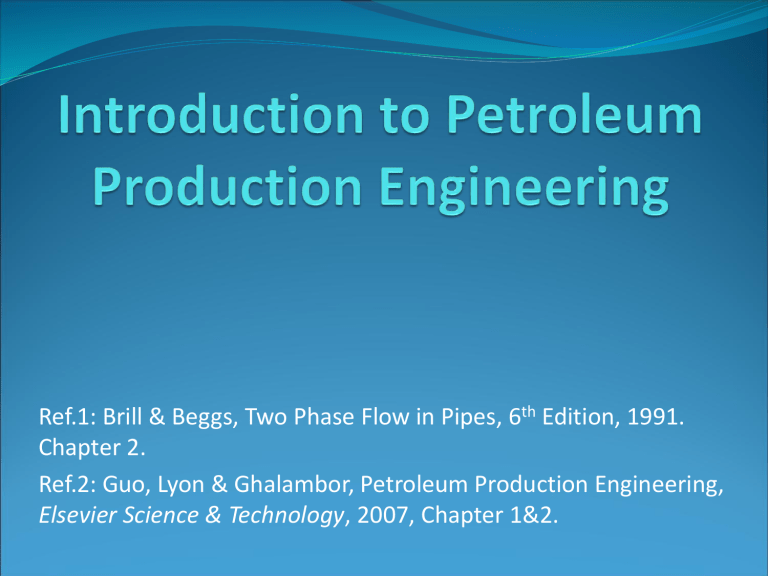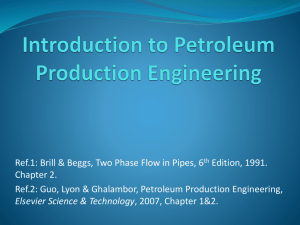Thermodynamic Property Methods

Ref.1: Brill & Beggs, Two Phase Flow in Pipes, 6 th Edition, 1991.
Chapter 2.
Ref.2: Guo, Lyon & Ghalambor, Petroleum Production Engineering,
Elsevier Science & Technology, 2007, Chapter 1&2.
Introduction
A complete oil or gas production system consists of a reservoir , well , flowline , separators , pumps , and transportation pipelines .
Introduction
A ‘‘ reservoir ’’ is a porous and permeable underground formation containing an individual bank of hydrocarbons confined by impermeable rock or water barriers and is characterized by a single natural pressure system.
Hydrocarbon accumulations are classified as oil , gas condensate , and gas reservoirs.
Gas wells : GOR >100,000 scf/stbo Compositional model
Gas condensate wells : 5,000<GOR< 100,000 scf/stbo
Oil wells : GOR< 5,000 scf/stbo Black oil model
Black Oil Model
Gas Oil Ratio
‘‘Solution GOR’’ is defined as the amount of gas (in standard condition) that will dissolve in unit volume of oil when both are taken down to the reservoir at the prevailing pressure and temperature; that is,
R s
Gas volume in standard conditions
Oil volume in stock tank conditions standard condition is 14.7 psia and 60 o F
( scf )
( stbo )
R s remains constant at pressures above bubble-point pressure. It drops as pressure decreases in the pressure range below the bubble-point pressure.
Black Oil Model
Gas Oil Ratio
Lasater correlation (recommended for o API>15):
P ( psia
T
) g
1. Calculate o gd
( R ) g gd is sp. gr. of dissolved gas at sc.
2. Obtain y g from
3. Obtain M o from
4. Calculate R s
( 379 .
3 )( 350 )
M o g o
1
y g y g
C
C is the tuning parameter (default value of C is 1.0).
Black Oil Model
Gas Oil Ratio
Standing correlation (recommended for o API<15):
Calculate
R s
g gd
P ( psia
18
) 10
0 .
0125 o
API
10
0 .
00091 T ( o
F )
1 .
2048
C
C is the tuning parameter (default value of C is 1.0).
Black Oil Model
Oil Formation Volume Factor
‘‘Oil formation volume factor’’ is defined as:
B o
Oil volume in reservoir conditions
Oil volume in stock tank conditions
( bbl )
( stbo )
B o is always greater than unity.
At a given reservoir temperature, B o remains nearly constant at pressures above bubble-point pressure. It drops as pressure decreases in the pressure range below the bubble point pressure.
Black Oil Model
Oil Formation Volume Factor
Standing correlation :
B o
0 .
972
0 .
000147
R s
g g gd o
0 .
5
1 .
25 T ( o
F )
1 .
175
C
C is the tuning parameter (default value of C is 0.0).
Res. Cond.: P, T
Free gas: m gf
(lbm)
Oil: F o
(bbl)
Density:
o
(lbm/ft 3 )
Black Oil Model
Oil Density
Free gas: m gf
(lbm)
Dissolved gas: V gd
(scf)
Dissolved gas density:
gd
(lbm/scf) = g gd
(0.0764)
S.C.
P =14.73 psia
T = 60 o F
Oil: L o
(stbo)
Oil density:
Lo
(lbm/scf) = g o
(62.4)
Mass Balance: m gf
5 .
614 F o
o
m gf
V gd
gd
5 .
614 L o
Lo
o
V gd
L o
5 .
614 gd
F o
5 .
614
L o
Lo o
0 .
0136 R s g gd
B o
62 .
4 g o
Black Oil Model
Specific Gravity of Free Gas
Gas Mass Balance:
Total produced gas at s.c. = Dissolved gas + Free gas
R p
L o
0 .
0764 g gt
R s
L o
0 .
0764 g gd
R p
R s
o
0 .
0764 g gf
g gf
R p g gt
R p
R s
R s g gd
,
0 .
56
0 .
56
g g gf gd
g and gt g gt
g gd
Where R p is the produced Gas Oil Ratio ( R p
≥ R s
).
Black Oil Model
Oil Viscosity
1- Viscosity of saturated oil (Beggs and Robinson):
A- Dead oil viscosity ( P =1.0 atm)
OD
10
X
1 , X
10
( 3 .
0324
0 .
02023 o
API )
T
1 .
163
, T
o
F
B- Live oil viscosity
o
( cp )
A
B
OD
, A
R s
10 .
715
100
0 .
515
, B
R s
5 .
44
150
0 .
338
Black Oil Model
Oil Viscosity
2- Viscosity of undersaturated oil (Vazquez):
o
ob
P
P b
m
, m
10
2 .
6 P
3 .
9
10
5
1 .
187
P
5 .
0
Procedure for calculating P b
:
Assume P b
= P and calculate R s
(from Standing or Lasater)
If R s
> R p the oil is undersaturated, otherwise the oil is saturated
For undersaturated oil, assume R s
= R p
Calculate P b from Standing or Lasater correlation.
Black Oil Model
Oil Viscosity
Standing Correlation:
A- Dead oil viscosity ( P =1.0 atm)
OD
0 .
32
1 .
8
10
7 o
API
4 .
53
T
360
( o
F)
200
A
, A
10
0 .
43
8 .
33 o
API
B- Saturated oil viscosity
o
( cp )
10 a b
0 .
68
10
8 .
62
10
5
R s
b
OD
, a
R s
0 .
25
10
1 .
10
10
3
R s
2 .
2
10
7
R s
0 .
062
10
3 .
74
10
3
R s
7 .
4
10
4
C- Undersaturated oil viscosity
o
ob
0 .
001 ( P
P b
)
0 .
024
1 .
6 ob
0 .
38
0 .
56 ob
Black Oil Model
Gas-Oil Surface Tension
Baker and Swerdloff correlation:
1- Dead oil surface tension ( s
OD
): An estimate of oil surface tension at atmospheric pressure, can be obtained from
Note: Extrapolation beyond the temperature rang of [68 o F 100 o F] is not recommended.
2- Live oil surface tension ( s
O
): The surface tension of crude oil containing dissolved gas expressed as a percent of s
OD can be obtained from
Black Oil Model
Free Gas Density
1- Engineering Equation of state:
P V
z n R T
gf
P M gf z R T
M gf
M air g gf
gf
P g gf
10 .
72
29 z T
gf lbm ft
3
2 .
70 g gf
P ( psia ) z T ( o
R )
Black Oil Model
Free Gas Density
2- Gas formation volume factor ( B g
):
B g
V
V sc
gf
z n R T z sc n
P
R T sc
P sc
gf sc
B g
0 .
0283 z T ( o
R )
P ( psia )
air sc
B g g gf
gf lbm ft
3
0 .
0764
γ gf
B g
Black Oil Model
Free Gas Compressibility Factor
1Standing and Katz
pr
T pc pr
P pc
2Brill and Beggs correlation: z
A
( 1
A ) e
B
C
D
P pr
A
1 .
39 ( T pr
0 .
92 )
0 .
5
0 .
36 T pr
0 .
1
B
( 0 .
62
0 .
23 T pr
) P pr
T pr
0 .
066
0 .
86
0 .
037
2
P pr
0 .
32 P
6 pr
10
9 ( T p r
1 )
C
0 .
132
0 .
32 log
10
( T pr
)
D
10
( 0 .
3106
0 .
49 T p r
0 .
1824 T
2 p r
)
Black Oil Model
Free Gas Pseudocritical Properties
1Brown et al.
Valid for H
2
S < 3%, N
2
< 5%, and total content of inorganic compounds less than 7%.
P pc
( psia )
709 .
604
58 .
718 g gf
T pc
( o
R )
170 .
491
307 .
344 g gf
2Ahmed correlation:
P pc
( psia )
T pc
( o
R )
678
50 ( g gf
326
315 .
7 ( g gf
0 .
5 )
206 .
7 y
N
2
0 .
5 )
240 y
N
2
440 y
CO
2
83 .
3 y
CO
2
606 .
7 y
H
2
S
133 .
3 y
H
2
S
Black Oil Model
Free Gas Viscosity
1Carr et al. correlation:
A- Gas viscosity at atmospheric pressure (
1
Valid for 40 < T ( o F) < 400
B- Viscosity ratio (
/
1
Valid for 1.0 < P pr
< 20.0
C- Free gas viscosity:
gf
( cp )
1
1
Black Oil Model
Free Gas Viscosity
2Lee et al. correlation:
gf
( cp)
1
10
4
K exp
X
( 2 .
4
0 .
2 X gf
)
K
( 9 .
4
0 .
02 M gf
209
19 M gf
) T
T
1 .
5
X
3 .
5
Where T
986
0 .
01 M gf
T
o
F and
gf
gr cm
3
0 .
0433 g gf
P ( psia ) z T ( o
R )
Black Oil Model
Water (Brine) Density
A- Water formation volume factor ( B w
):
B w
B w
' y
B w
B- Water density (
w
):
w
w sc
B w
Black Oil Model
Water Viscosity
A- Viscosity of pure water ( Van Wingen correlation):
w
’
:
B- Viscosity of brine ( Frick correation):
w
(cp) =
w
’ Ratio
, Ratio :
Compositional Model
The critical properties of components that are usually found in gas
and gas condensate wells are shown in this Table
.
The components that are heavier than n-Hexane are usually shown as a pesudocomponent (C
7
+ ).
For calculating the properties of gas and gas condensate wells, the compositional model is recommended.
Many gas or gas condensate wells exhibit retrograde condensation , phenomena in which condensation occurs during pressure reduction (shaded region within the two-phase envelope of
).
Compositional Model
Flash Calculation
Free gas flowrate: V
Composition: y i
Res. Cond.: P, T
Composition: Z i for i =
1, … , n
Mole flowrate : F
Equilibrium
Flash
K i
= y i
/ x i
Condensate flowrate: L
Composition: x i
At equilibriu
By definition
Therefore m : f i v
: f i v
: K i
y i x i f i l y i
P
i v
,
i l
i v f i l x i
P
i l
SRK or PR
Compositional Model
Gas and Liquid Density
Once the compressibilities of each phase is determined, the gas and liquid densities can be determined from:
V
P M
V
Z
V
R T
, M
V
i n
1 y i
M i
L
P M
L
Z
L
R T
, M
L
i n
1 x i
M i
Other properties can be calculated based on the composition of liquid and gas phases ( GPSA, Engineering Data Book , 11 th edition, 1998, Chapter 23 ).
Compositional Model
Pesudocomponents
If you like to use compositional model for oil wells, the oil must defined as some pesudocomponents based on distillation curve.
There are several methods of measuring and reporting distillation curves of crude oil and petroleum fractions:
1- ASTM D 86
2- True Boiling Point (TBP)
3- Simulated Distillation by GC (ASTM D 2887)
4- Equilibrium Flash Vaporization (EFV)
5- Distillation at Reduced Pressures (ASTM D 1160)





